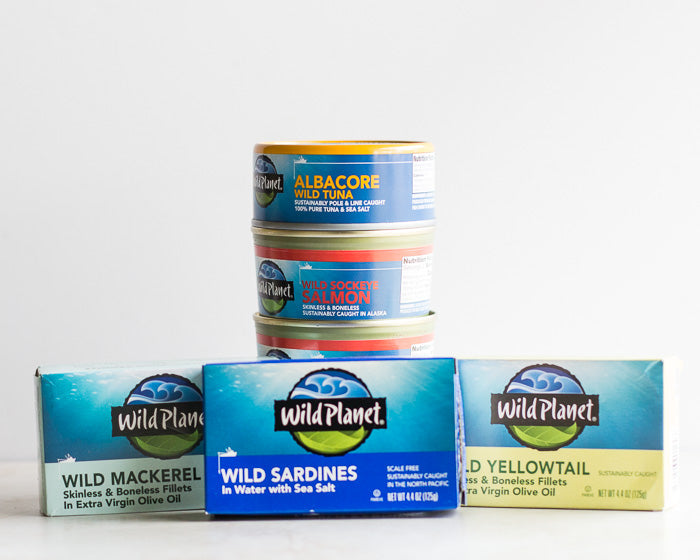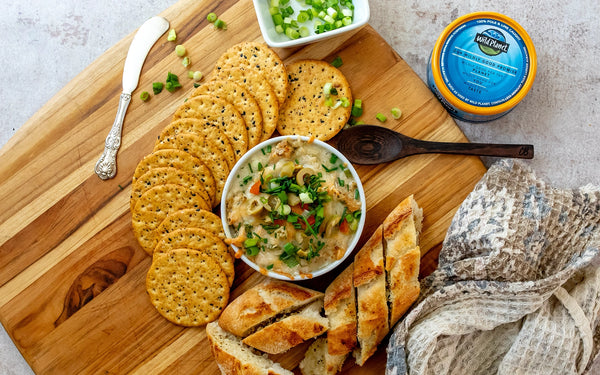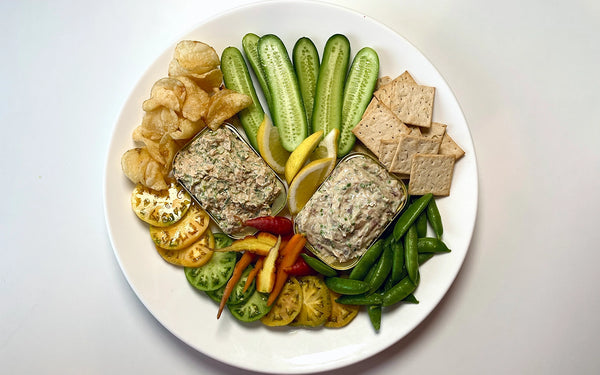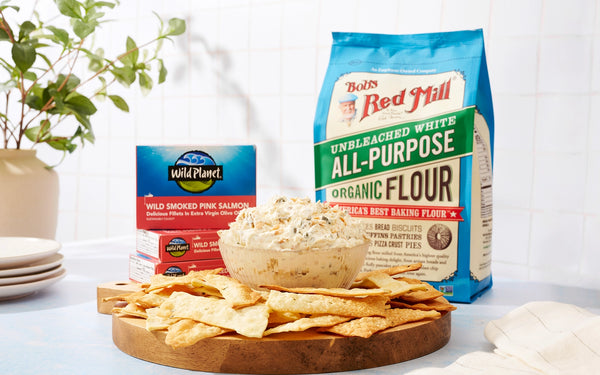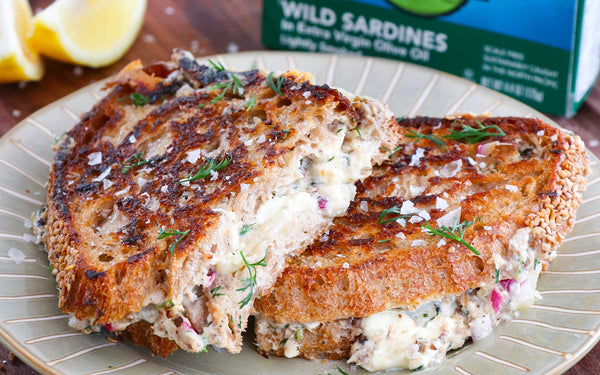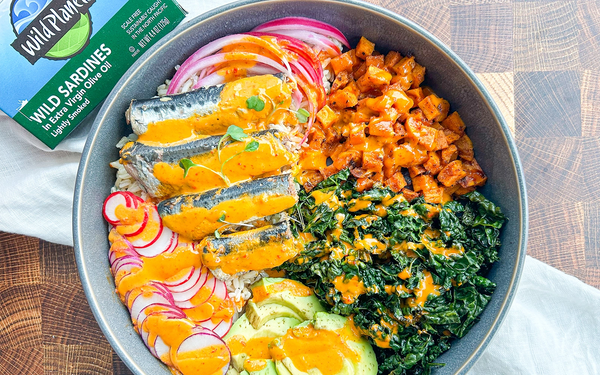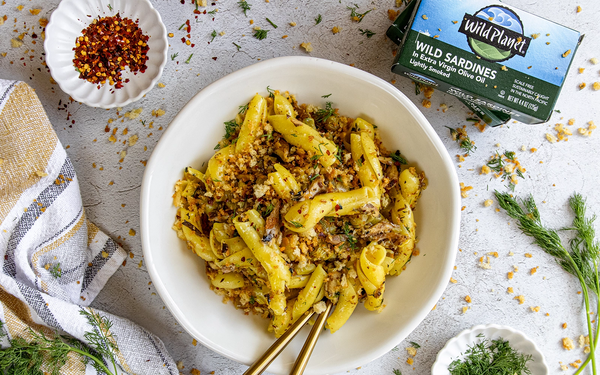Ever wonder how to get more omega-3 fatty acids into your diet as a pregnant or nursing mother? Read on to discover how important omega-3s are to your baby’s development—and your own health — studies suggest they can even help ward off post-partum depression! Learn which is the best seafood to shop for, how much is recommended per week and a few fun ways to add them into your routine. Tune in because we've invited Min Kwon from MJ & Hungry Man to talk about all of the above and then some! 
What comes to mind when you think of omega-3 fatty acids? While they are mainly associated with heart health, these essential fats offer a long list of additional health benefits. Today I want to put the spotlight on omega-3 fatty acids and specifically, how important they are for pregnant women, babies, and children. WHAT IS OMEGA 3 FATTY ACIDS (FA)? Omega-3s are ESSENTIAL fatty acids that MUST be consumed from diet or supplementation. They have many critical, health-promoting roles in our bodies: There are 3 types of Omega-3 fatty acids: alpha-linolenic acid (ALA), eicosapentaenoic acid (EPA), docosahexaenoic acid (DHA)
There are 3 types of Omega-3 fatty acids: alpha-linolenic acid (ALA), eicosapentaenoic acid (EPA), docosahexaenoic acid (DHA)
 BEST SOURCES: On the top of the list are cold water fish: Salmon, sardines, mackerel (avoid king), herring, fresh tuna, halibut Fish is an excellent source of protein, omega-3 fatty acids, several vitamins and minerals (such as vitamin D, iron, choline, zinc) and is low in saturated fat. Keep in mind the amount of omega-3 FAs varies in wild vs. farm-raised and among varieties of fish. Wild-caught will always be your best choice as it has higher levels of omega-3 FAs and are more sustainable. Whenever possible, I highly encourage you to support companies that follow sustainable, earth-friendly practices, like Wild Planet Foods.
BEST SOURCES: On the top of the list are cold water fish: Salmon, sardines, mackerel (avoid king), herring, fresh tuna, halibut Fish is an excellent source of protein, omega-3 fatty acids, several vitamins and minerals (such as vitamin D, iron, choline, zinc) and is low in saturated fat. Keep in mind the amount of omega-3 FAs varies in wild vs. farm-raised and among varieties of fish. Wild-caught will always be your best choice as it has higher levels of omega-3 FAs and are more sustainable. Whenever possible, I highly encourage you to support companies that follow sustainable, earth-friendly practices, like Wild Planet Foods.  Other sources:
Other sources:
 PREGNANCY: Consuming an adequate amount of omega-3 FAs is highly encouraged but even more so during pregnancy and beyond!
PREGNANCY: Consuming an adequate amount of omega-3 FAs is highly encouraged but even more so during pregnancy and beyond!

What comes to mind when you think of omega-3 fatty acids? While they are mainly associated with heart health, these essential fats offer a long list of additional health benefits. Today I want to put the spotlight on omega-3 fatty acids and specifically, how important they are for pregnant women, babies, and children. WHAT IS OMEGA 3 FATTY ACIDS (FA)? Omega-3s are ESSENTIAL fatty acids that MUST be consumed from diet or supplementation. They have many critical, health-promoting roles in our bodies:
- Important for healthy brain and eye development
- Part of the process of building new cells
- Helps body absorb fat-soluble nutrients
- Improves heart health
- Fights inflammation
- While more research is needed, some studies have shown that due to their role in neurotransmitter function, these fats may help manage psychological and behavioral conditions, such as ADHD, as well as improve cognitive function
 There are 3 types of Omega-3 fatty acids: alpha-linolenic acid (ALA), eicosapentaenoic acid (EPA), docosahexaenoic acid (DHA)
There are 3 types of Omega-3 fatty acids: alpha-linolenic acid (ALA), eicosapentaenoic acid (EPA), docosahexaenoic acid (DHA)
- ALA is a short chain fatty acid which gets converted to the biologically active longer chain omega-3 FA, EPA, which then gets converted to DHA
- EPA supports the heart, immune system, and inflammatory response.
- DHA is a critical building block for brain, retina, and central nervous system, which is why it is especially important for pregnant and lactating women.
 BEST SOURCES: On the top of the list are cold water fish: Salmon, sardines, mackerel (avoid king), herring, fresh tuna, halibut Fish is an excellent source of protein, omega-3 fatty acids, several vitamins and minerals (such as vitamin D, iron, choline, zinc) and is low in saturated fat. Keep in mind the amount of omega-3 FAs varies in wild vs. farm-raised and among varieties of fish. Wild-caught will always be your best choice as it has higher levels of omega-3 FAs and are more sustainable. Whenever possible, I highly encourage you to support companies that follow sustainable, earth-friendly practices, like Wild Planet Foods.
BEST SOURCES: On the top of the list are cold water fish: Salmon, sardines, mackerel (avoid king), herring, fresh tuna, halibut Fish is an excellent source of protein, omega-3 fatty acids, several vitamins and minerals (such as vitamin D, iron, choline, zinc) and is low in saturated fat. Keep in mind the amount of omega-3 FAs varies in wild vs. farm-raised and among varieties of fish. Wild-caught will always be your best choice as it has higher levels of omega-3 FAs and are more sustainable. Whenever possible, I highly encourage you to support companies that follow sustainable, earth-friendly practices, like Wild Planet Foods.  Other sources:
Other sources:
- Beef (grass-fed animals will have a higher amount)
- Free range chicken
- Flaxseeds
- Walnuts
- Chia seeds
- Soy beans
- Eggs
- Milk
- Yogurt (grass-fed)
 PREGNANCY: Consuming an adequate amount of omega-3 FAs is highly encouraged but even more so during pregnancy and beyond!
PREGNANCY: Consuming an adequate amount of omega-3 FAs is highly encouraged but even more so during pregnancy and beyond!
FOR MOMS: Along with the health benefits mentioned above, studies show that they may play a role in reducing the risk of premature delivery and in protecting against postpartum depression. Again, the best sources of omega-3 FAs are fish, but because of the concerns regarding mercury levels and other environmental contaminants, many pregnant women are afraid to consume them, resulting in potentially depriving the fetus of essential nutrients. The 2015-2020 Dietary Guidelines for Americans recommends women who are pregnant or breastfeeding to consume 2-3 servings (8-12 ounces) per week of seafood low in mercury (see list above). Generally speaking, large predatory fish, like tuna, shark, and swordfish contain higher levels of mercury so it is best to stay away from them.
FOR BABIES AND CHILDREN: What moms eat during pregnancy matters! Omega-3 FAs are transferred across the placenta, and during the third trimester of pregnancy, 50-60 mg per day of the mother’s DHA stores go to her fetus. And after birth, DHA is transferred through breast milk. In a 2015 review article that looked at cognitive development in infants born to mothers who consumed seafood throughout pregnancy compared to those that didn’t, a significantly improved visual acuity, language and social activity scores (e.g. hand-eye coordination, vocabulary comprehension) before the age of 2 were observed. The beneficial effects of consumption of adequate omega-3 fatty acids during pregnancy have also been shown to continue into early childhood. The children displayed better:
 If you’ve been following our baby led weaning journey on Instagram @kidfriendly.meals where I’ve been sharing our meals since day 1, you know sardines make a regular appearance on my son’s plate. Right now, I want to share my favorite quick and easy, delicious ways that you can try to get your little one(s) excited about them!
If you’ve been following our baby led weaning journey on Instagram @kidfriendly.meals where I’ve been sharing our meals since day 1, you know sardines make a regular appearance on my son’s plate. Right now, I want to share my favorite quick and easy, delicious ways that you can try to get your little one(s) excited about them!
—
- Fine motor skills, social skills
- Communication skills
- Higher verbal and performance IQ
- And less behavioral problems.
- 6 months to 2 years: 3-4 ounces seafood per week
- 2-4 years: 6 ounces of seafood per week
 If you’ve been following our baby led weaning journey on Instagram @kidfriendly.meals where I’ve been sharing our meals since day 1, you know sardines make a regular appearance on my son’s plate. Right now, I want to share my favorite quick and easy, delicious ways that you can try to get your little one(s) excited about them!
If you’ve been following our baby led weaning journey on Instagram @kidfriendly.meals where I’ve been sharing our meals since day 1, you know sardines make a regular appearance on my son’s plate. Right now, I want to share my favorite quick and easy, delicious ways that you can try to get your little one(s) excited about them!
- Oatmeal: mash avocado, sardines, finely ground nuts/seeds, or whatever ingredients you fancy! Simply preload onto a spoon
- Oat balls: same as above but this time shape into balls! Super finger-friendly! Great practice for pincer grasp
- Sandwich: make sardine avocado salad – 1/2 avocado, 1 sardine fillet, chopped veggies (whatever you have on hand), spoonful of whole fat plain greek yogurt (optional)
- Can use the salad as a filling for sandwiches, serve over cooked grains, pasta, etc.
- Baked goods: add to barley casserole cups (recipe in my 2nd e-cookbook), savory muffins, fish cakes, etc.
- As is: I personally can’t eat it whole so guess that’s why I didn’t serve it to him this way until Caleb was around 13 months, but you can certainly offer sooner! Caleb absolutely LOVED it plain

